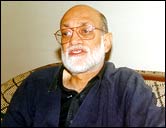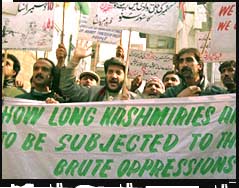A decade of bloodshed... yet the end is not in sight
Chindu Sreedharan
Ten years, thousands of lives, billions of rupees -- and not a lesson learnt.
Strange... or is it?
Were you a student of the Kashmir conflict you wouldn't think so. Nothing strange there, you would say with a wry smile. It is as expected.
Yes?
Yes. Wade through the history of insurgency if you dare. Oh, never mind the blood. Never mind the tears. Step over those corpses, if you please, step right over them... Stop when you reach the early 80s.
Now look sharp. Look sharp down that bloody lane at the political masters that have ruled Delhi... Do you not notice it? Do you not notice the common thread that ties them together?
You do.
You see their attitude towards Kashmir. You hear their vociferous cries: 'Kashmir is an integral part of India. We will not let it go.'
And?
And then you see them imitating ostriches. Burying their heads and pretending not to see what's brewing.
Finally, when they are forced to take notice, when they
can't but take notice, you see them prescribing symptomatic treatment. Sending in troops by the planeload. Then you see them putting their heads down again...
'Kashmir is okay, Kashmir is fine,' you hear them say. 'It is on the path to peace.'
Kashmir is not okay. Kashmir is not fine.
In fact, the conflict is at its worst today. The series of attacks on army camps, increased number of encounters and heightened security operations all support this -- a view which both the state and central governments are at pains to contradict.
The recent spurt of violence, they say, is just that: a spurt. Another wave that will soon subside.
"The tensions and pressures that used to be there in 89, 90 and 91, those are not present anymore. Of course, there is a long way to go, but the situation is much better," says J&K Chief Secretary Ashok Jaitley.
 "The local support has died down. There is the realisation (on the part of Kashmiris) that, look, gun cannot solve this problem. Now violence is confined to only certain pockets," he adds.
"The local support has died down. There is the realisation (on the part of Kashmiris) that, look, gun cannot solve this problem. Now violence is confined to only certain pockets," he adds.
The Kashmiri on the street, however, differs. Things are worse than before, he maintains. There was a time when you used to know what would happen, and when. You used to know who was the militant, who was not. Not anymore.
A senior Border Security Force officer in New Delhi, who spoke to rediff.com in confidence, supports this.
"The situation is at its worst... I don't see any improvement in the near future," he admits. "We are finding problems on several fronts... An important one is the lack of co-ordination among security agencies involved in Kashmir."
The government's claim that local support to militancy has died down doesn't swing much weight either. "Make no mistake about it, the locals still support militants," a keen Kashmir watcher says, summing up the sentiments of many.
"The Kashmiri may be disillusioned with militancy. He knows that India will not stop at anything when it comes to pursuing its interest in Kashmir. But his sympathies are still with the people who fight for him. The militants are still his heroes," he holds.
If that wasn't so, he asks, how is it that militants are operating so efficiently?
Jaitley's claim is that the militants are not 'operating'. "What the Inter-Services Intelligence (the Pakistani intelligence agency that supports the Kashmiri insurgents) does is send in people saying, okay, you go in, spend your six months," he counters. "So the militants come in. Once here they sit on mountains in hideouts. They do not operate."
Then how would he explain the attack on 15 Corps headquarters in Srinagar?
"That sort of thing can happen any time. I don't think it should get us into panic," Jaitley answers.
Different folks, different strokes. So what's the truth about the situation?
rediff.com's inquiries throw up these facts: The security situation in Jammu and Kashmir is, to repeat, at its worst. Between 3,000 and 5,000 'hardcore' militants currently operate in the state. The number of army and paramilitary personnel deployed for counterinsurgency has peaked. Conservative estimates put it at 200,000-odd, a figure which could go up by summer.
The Kargil conflict contributed majorly to this state of affairs. Thousands of army personnel were pulled out from anti-militancy duties and re-deployed at the border. This left huge gaps in the counterinsurgency grid. Result: some '1500-2000' militants infiltrated.
The coup in Pakistan too did its share. The military regime is expected to 'stir up things in a bigger way.' Permitting the Lashkar-e-Toiba conference in Pakistan is seen as an indicator to this.
"We are in for a difficult winter," admits an officer of India's premier intelligence agency, the Research and Analysis Wing. "You normally see exfiltration every year before the passes close. This time that has been comparatively low. Also, those who came in had a huge number of porters to bring in stocks. So it seems that these chaps are here to stay and fight."
The complexion of militancy has undergone a major change. For one, local militants are fewer today. Opinions differ on the actual percentage. While most intelligence officers put the foreign to local militant ratio at 80:20, Kashmiris and Kashmir watchers swear that this is incorrect. The number of foreigners, they claim, is lower than that of the locals -- or else how would you explain the fact that security forces kill more local militants than foreigners everyday?
One aspect that everyone agrees on is that the militants today are better trained and equipped. "They used to come in with Chinese pistols and AK-47s. Now they have Universal machine-guns, missiles, rocket launchers, grenade-throwing rifles capable of throwing six grenades in six seconds and improvised explosives with great sophistication," reveals the RAW official.
"The communication sets provided to their leadership have in-built speech scrambling devices capable of transmitting data in code at high speed," he adds. "They are recruiting science graduates to maintain these equipment. Which all very clearly shows that they are prepared for a long drawn-out war."
All intelligence officers point to an alarming fact: The conflict is taking on a pan-Islamic hue. "The rumours about Osama bin Laden's involvement are not just rumours. Now with the Taliban controlling 90 per cent of Afghanistan, the Islamisation of the Pakistan army that General Zia-ul-Haq started is slowly bearing fruits," one officer says.
"With the establishment of a regime in Afghanistan, they have got strategic depth," he continues. "Now they want to stretch and get the Kashmir territory. They would, thus, have a huge landmass where they could have the Shariat."
The ISI, they claim, pumps in between Rs 1.5 billion and Rs 2 billion every year into the conflict. Besides, there are over 1.2 million Kalashnikovs left over from the Afghan war, which are being used for the Kashmir jihad.
The RAW officer sees another indication of the things to come. "To attract local youths, the ISI has started paying compensation to militants killed in the last four or five months. Rs 50,000 is the going rate," he reveals.
"The families of arrested militants get Rs 12,000 annually. It is a very clear design to boost morale and attract fresh recruits," he says.
'Militancy thrives on the sense of alienation' Read on...




